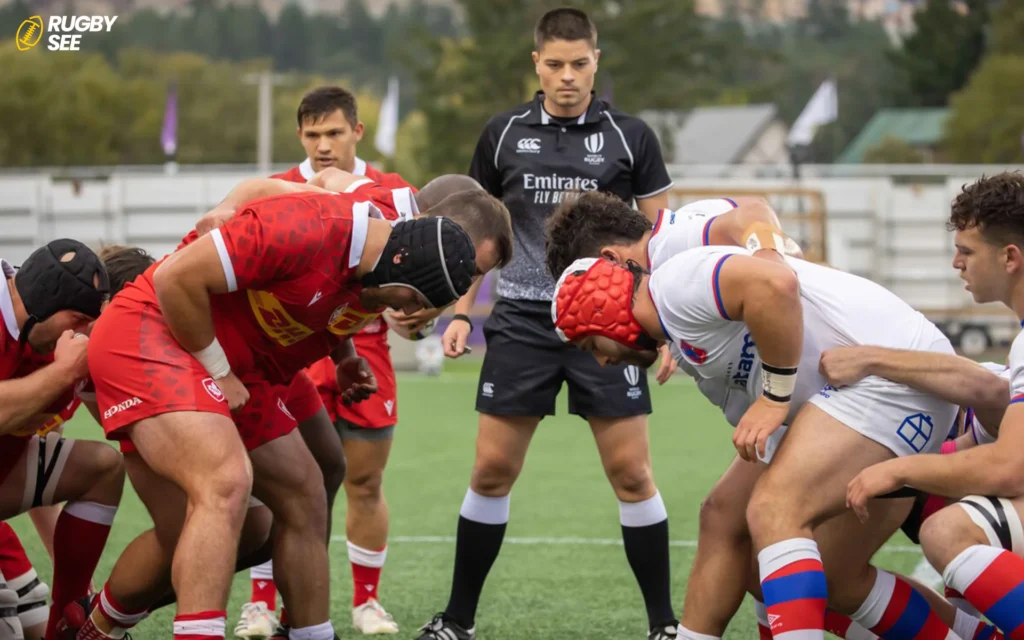Rugby, recognized for its physicality and strategic depth, often features players of significant strength and large stature. This very aspect has led to the emergence of questions among the audience of this sport.
This article explores the reasons behind the impressive physiques of rugby players, delving into aspects of training, diet, the demands of the sport, and genetic factors.
The Demands of Rugby
Rugby is a sport that requires a unique blend of strength, speed, endurance, and tactical skill. The nature of the game dictates the physical attributes needed by players.
Physicality and Contact
- Tackling and Ball Carrying: Rugby involves frequent physical confrontations. Players need to be big and strong to tackle effectively and to withstand tackles.
- Rucks and Mauls: These are crucial aspects of the game where size and strength are significant advantages.
Position-Specific Requirements
- Forwards: These players are generally bigger, focusing on strength and power to win scrums and lineouts.
- Backs: While also requiring size, they tend to be slightly smaller and more agile, focusing on speed and quick movements.
Training Regimens
Rugby players undergo rigorous training regimens that contribute significantly to their size and strength.
Strength and Conditioning
- Weight Training: Essential for building muscle mass and strength.
- Cardiovascular Training: Ensures players have the endurance needed for the game’s duration.
Skills Training
- Tactical Drills: Develops the specific skills needed for various positions.
- Team Drills: Focus on coordination and game strategies.
Nutrition and Diet
A key factor in the size of rugby players is their diet.
High-Calorie Diets
- Protein-Rich Foods: Necessary for muscle repair and growth.
- Carbohydrates: Provide the energy required for intensive training and matches.
Hydration and Recovery
- Fluid Intake: Essential for maintaining peak physical performance.
- Recovery Meals: Help in muscle recovery and preparation for the next training or game.
Genetic and Physiological Factors
Some players have a natural predisposition to size and muscle growth.

Genetic Makeup
- Natural Physique: Some players are genetically predisposed to being larger and more muscular.
- Fast and Slow Twitch Muscle Fibers: Different players may have a genetic advantage in either strength (fast twitch) or endurance (slow twitch) muscle characteristics and if you want to know about getting big for Rugby read How Do Rugby Players Get So Big.
The Evolution of Rugby Players
Over the decades, rugby players have become bigger due to changes in training, nutrition, and the professionalization of the sport.
Professionalism and Its Impact
- Full-time Training: Allows for more dedicated and specialized training.
- Scientific Approach: The use of sports science has optimized training and nutrition.
Iconic Rugby Players and Their Physiques
Over the years, rugby has seen players whose size and strength have made them legends of the sport.
Examples of Notable Players
- Jonah Lomu: Known for his incredible size and speed, Lomu was a game-changer in rugby.
- Martin Johnson: His formidable presence as a lock was crucial for England’s success.
These players exemplify how size and strength can be leveraged to achieve greatness in rugby.
Advanced Training Techniques
Today’s rugby players benefit from advanced training techniques that enhance their size and abilities.
Specialized Training Programs
- Position-Specific Training: Tailored to the needs of different positions on the field.
- Injury Prevention: Focuses on strengthening areas prone to injury in rugby.
Use of Technology
- Wearable Tech: Monitors performance and physical condition.
- Video Analysis: Helps in refining techniques and strategies.
Diet and Nutrition: Beyond the Basics
Rugby players follow complex nutrition plans to fuel their bodies for peak performance.
Personalized Diet Plans
- Nutritionists: Many players work with nutritionists to tailor their diets to their specific needs.
- Supplementation: Use of supplements to aid in recovery and performance.
Understanding the Balance
- Off-Season vs. In-Season Diets: Adjustments based on training intensity and game schedules.
- Hydration Strategies: Critical for performance, especially in high-intensity matches.
The Psychological and Social Impact
The size and stature of rugby players have psychological and social implications.
Intimidation Factor
- Psychological Edge: Larger players can intimidate opponents, gaining a mental advantage.
- Confidence: Physical presence can boost a player’s own confidence and team morale.
Role Models and Public Perception
- Inspiration: Many players become role models for aspiring athletes.
- Media Representation: The portrayal of rugby players in media influences public perception of the sport.
The Future of Rugby Physiques
As rugby continues to evolve, so will the size and conditioning of its players.

Predictions and Trends
- Continued Growth: Players may become even bigger and stronger with advancements in training and nutrition.
- Balancing Agility: Emphasis on maintaining agility and speed despite increasing size.
The size and strength of rugby players are the results of the players’ efforts and rigorous training, specialized diet plans, and sometimes genetic factors. This combination of elements ensures that rugby players are equipped to meet the challenges of this demanding sport
Athletic Evolution in Rugby
Rugby has always been a sport that demands a high level of physicality. However, the nature of these demands has shifted over the years. The modern game places a premium on speed, agility, and endurance, in addition to the traditional emphasis on strength and size. This shift is influencing the training and development of players, with a growing focus on creating athletes who can perform at high intensities for longer periods.
The Impact of Professionalism
The advent of professionalism in rugby has had a profound impact on player physiques. With access to advanced training facilities, nutritional guidance, and sports science, players are now able to achieve and maintain optimal physical conditions. Professionalism has also led to a more scientific approach to training, where individual programs are tailored to enhance specific physical attributes, from explosive power to aerobic capacity, depending on the player’s position and the team’s strategy and if you want to know about making money in Rugby read Does Rugby Make Money? A Comprehensive Analysis.
Position-Specific Physiques
The future of rugby physiques is also being shaped by the specialization of positions. Gone are the days when forwards were uniformly bigger than backs. Today, the physical requirements of each position are more nuanced. For instance, a prop needs a powerful build to excel in scrummaging, while a winger benefits from a leaner physique that maximizes speed and agility. This trend towards position-specific physiques is expected to continue, with players becoming even more specialized in their physical development.
The Role of Technology and Data Analytics
Technology and data analytics are playing an increasingly important role in shaping rugby physiques. Wearable technology allows for the monitoring of player performance in real time, providing insights into areas for physical improvement. Data analytics is used to predict and prevent injuries, ensuring players maintain peak physical condition. These tools are becoming indispensable in the development of future rugby stars.
Nutrition and Recovery
As the physical demands of rugby increase, so does the importance of nutrition and recovery in shaping player physiques. Proper nutrition fuels performance and recovery, allowing players to train harder and more frequently. Meanwhile, recovery techniques, including cryotherapy, massage, and compression therapy, are vital in managing the physical toll of training and matches. In the future, advances in nutrition and recovery methods will play a critical role in the development of rugby physiques.

Sustainability in Physique Development
Another aspect that will shape the future of rugby physiques is the growing emphasis on sustainability in athlete development. This means not just reaching peak physical condition but maintaining it healthily and safely over the course of a player’s career. Longevity will be a key focus, with training regimens designed to reduce wear and tear on the body, emphasizing injury prevention and the long-term well-being of the player.
Inclusivity and Diversity
The global expansion of rugby is bringing a greater diversity of body types and athletic backgrounds into the sport. This diversity is enriching the game, challenging traditional notions of the “ideal” rugby physique, and demonstrating that different body types can excel in different roles on the field. The future of rugby physiques will embrace this inclusivity, recognizing the strength in diversity and the benefits of having a mix of physical attributes within a team.
Adaptation to Rule Changes
The evolution of rugby physiques is also influenced by changes in the rules of the game. As the governing bodies of rugby continue to refine rules for safety, speed of play, and spectator enjoyment, players will adapt physically to meet these new demands. For example, if rules evolve to favor a faster-paced game, we might see a further shift towards leaner, more endurance-focused physiques across all positions and if you want to know about the reason that Rugby is the best sport read Why is rugby the best team sport.
Understanding Rule Changes in Rugby
Rule changes in rugby are not arbitrary; they are the result of extensive consultation and research by governing bodies like World Rugby. These changes typically aim to enhance player safety, speed up the game, and make it more spectator-friendly. From amendments in tackle laws to alterations in the scrum setup, each modification has a significant impact on how the game is played and coached.
The Impact on Players
For players, adapting to new rules is crucial for both performance and safety. Changes in tackle laws, for example, require players to modify their techniques to avoid penalties or injuries. This adaptation process often involves rigorous training sessions focused on the new requirements, with coaches incorporating specific drills that emphasize the updated laws. The ability to quickly adjust to these changes can give teams a competitive edge, making adaptability an essential skill for modern rugby players.

The Role of Coaches
Coaches play a pivotal role in helping teams navigate rule changes. They must first thoroughly understand the new laws, often participating in workshops and seminars organized by rugby governing bodies. With this knowledge, coaches adjust their team strategies and training regimens to align with the rule changes. This might mean altering defensive tactics, rethinking set-piece plays, or focusing on different aspects of fitness training. Coaches also need to instill a mindset of adaptability in their players, preparing them to respond positively to the challenges and opportunities presented by the rule changes.
Officials and Rule Enforcement
Referees and other match officials are at the forefront of implementing rule changes. Their understanding and interpretation of the laws directly affect how games are played and managed. Like players and coaches, officials undergo extensive training to familiarize themselves with the updated rules, often supported by video analysis and peer reviews. The accuracy and consistency of their decisions are critical, not just for the flow of individual games but for the broader acceptance and understanding of the rule changes within the rugby community.
The Fans’ Perspective
Rule changes can also significantly impact fans’ experience and enjoyment of the game. While some changes, particularly those that make the game faster and more exciting, are generally well-received, others may be met with skepticism or confusion. Engaging fans through clear communication, educational content, and transparent reasoning behind the changes is vital for maintaining and growing the sport’s fan base. Governing bodies and broadcasters often collaborate to produce explanatory content, leveraging social media and other platforms to reach a wide audience.
Adapting to Change: A Continuous Process
Adaptation to rule changes is a continuous process, reflecting the evolving nature of rugby. This adaptability is not just about overcoming challenges; it’s about seizing opportunities—whether that’s innovating new strategies, enhancing player development, or growing the sport’s global audience. The ongoing dialogue between players, coaches, officials, and fans is essential in this regard, creating a dynamic environment where the sport can thrive and if you want to know the reason of popularity of Rugby among people read Why do people watch rugby.
The Future of Rugby
Looking forward, the adaptability of the rugby community will continue to be tested as the sport faces new challenges, from the integration of technology to addressing health concerns like concussions. The commitment to adaptation and improvement among all stakeholders is what will drive rugby forward, ensuring it remains a beloved global sport for generations to come.
The Role of Genomics and Personalization
Looking further into the future, advancements in genomics and personalized medicine could revolutionize how rugby players train and develop their physiques. Understanding an individual’s genetic predisposition for certain physical traits could allow for highly customized training and nutrition programs, optimizing each player’s development based on their unique genetic makeup. This level of personalization would not only enhance performance but also minimize the risk of injury, contributing to the sustainability of the athlete’s career.










